When you first land on lizandmollie.com, you’re greeted with an endearing illustration of an elephant, lion, sloth and owl sitting around a conference table. One animal is bored, the other is yelling, another seems silently terrified and anxious — all meant to depict the wide range of emotions you might encounter in a team meeting. Emblazoned beneath this drawing sits an eye-catching tagline in a brushstroke font: “The future of work is emotional.” And judging by the early months of 2020 alone, that sentiment seems downright prophetic.
“We’ve never experienced this much uncertainty in such a short period of time. And the health component of being worried for the physical well-being of yourself, your friends and your family adds on another emotionally stressful layer,” says Liz Fosslien, one half of the eponymous duo behind this website.
“We’re all discovering in real time that we simply can’t cordon off our emotions when it’s time for work. There’s no tidy box to tuck them away in before we join that Zoom call. If you’ve spent your entire career trying to check your emotions at the office threshold or maintain a cool ‘professional’ exterior, this probably feels like uncharted territory. It’s incredibly overwhelming and scary. But there’s a silver lining: There's never been another time when it’s been this safe to get vulnerable at work. You’re stressed, anxious, isolated and terrified — but everyone else is too.”
Fosslien’s got a well of experience — and behavioral science — to back her up. Along with her co-author Mollie West Duffy, she has spent the better part of the last half decade studying teams, meeting with experts and researching the science behind emotions on the job, culminating in their excellent book "No Hard Feelings: The Secret Power of Embracing Emotions at Work." Fosslien also heads up content at Humu, a company that nudges people towards better work habits. She also shares her writing and illustrations in various outlets, which is why you’ve probably already seen her delightful drawings floating around the internet. (As she recently noted on Twitter, actor Joseph Gordon-Levitt shared one of her more popular illustrations.)

Last summer on the Review, we were fortunate to share a window into that work. Fosslien made the case for how tapping into your emotions can supercharge your career, putting together a guide with helpful pointers for dealing with seven “deadly” feelings we encounter in the workplace, including anxiety, envy, conflict and a lack of belonging. (If you have yet to read her Review article or pick up a copy of her and Mollie’s book, we highly recommend adding both to your reading stack.)
Given that her knack for helping us work through our emotions seems more relevant than ever, we decided to (virtually) sit down with Fosslien again to gather her advice for weathering the emotional storms we’re all facing. As usual, her tips were like a warm bowl of chicken soup, incredibly comforting and exactly what we needed.
In this exclusive interview, Fosslien draws from research for her book and her day-to-day work at Humu crafting helpful behavioral “nudges” to offer an emotional self-care guide to get you through our rapidly-changing circumstances. Whether you’re a startup founder looking to lead through uncertainty, a manager eager to guide your team or just a human hoping to keep your head on straight, this collection of sound advice will help ease the path forward.

HOW INDIVIDUAL CONTRIBUTORS CAN EMBRACE EMOTIONS:
"No Hard Feelings" covered a wide range of topics, from how to create belonging on remote teams and de-escalate conflict, to how to assess your emotional style and give satisfying feedback. “We like to say it’s a guide to un-repressing your emotions at work without letting them run wild,” says Fosslien. “The thread that connects all of these topics is the importance of not beating yourself up for feeling things, and instead listening to the needs behind your emotions.”
But that doesn’t mean these guidelines translate seamlessly into the emotional chaos we’ve all been plunged into. “I was joking with a friend recently that this is essentially the only scenario where Cognitive Behavioral Therapy’s challenging beliefs technique doesn't help. You’re supposed to write down the beliefs that are making you feel badly, and then ‘challenge’ them by writing down evidence for or against,” she says. “So much of it is centered on helping you see that you’re obsessing over unlikely worst-case scenarios — which isn’t exactly helpful when we’re living out what seems pretty close to a worst-case scenario: a global pandemic and an unprecedented economic downturn. So I’ve found that a lot of my normal psychological tools are not helping.”
So what is helpful these days? Below, Fosslien shares a handful of strategies that might be more soothing to meet this moment:
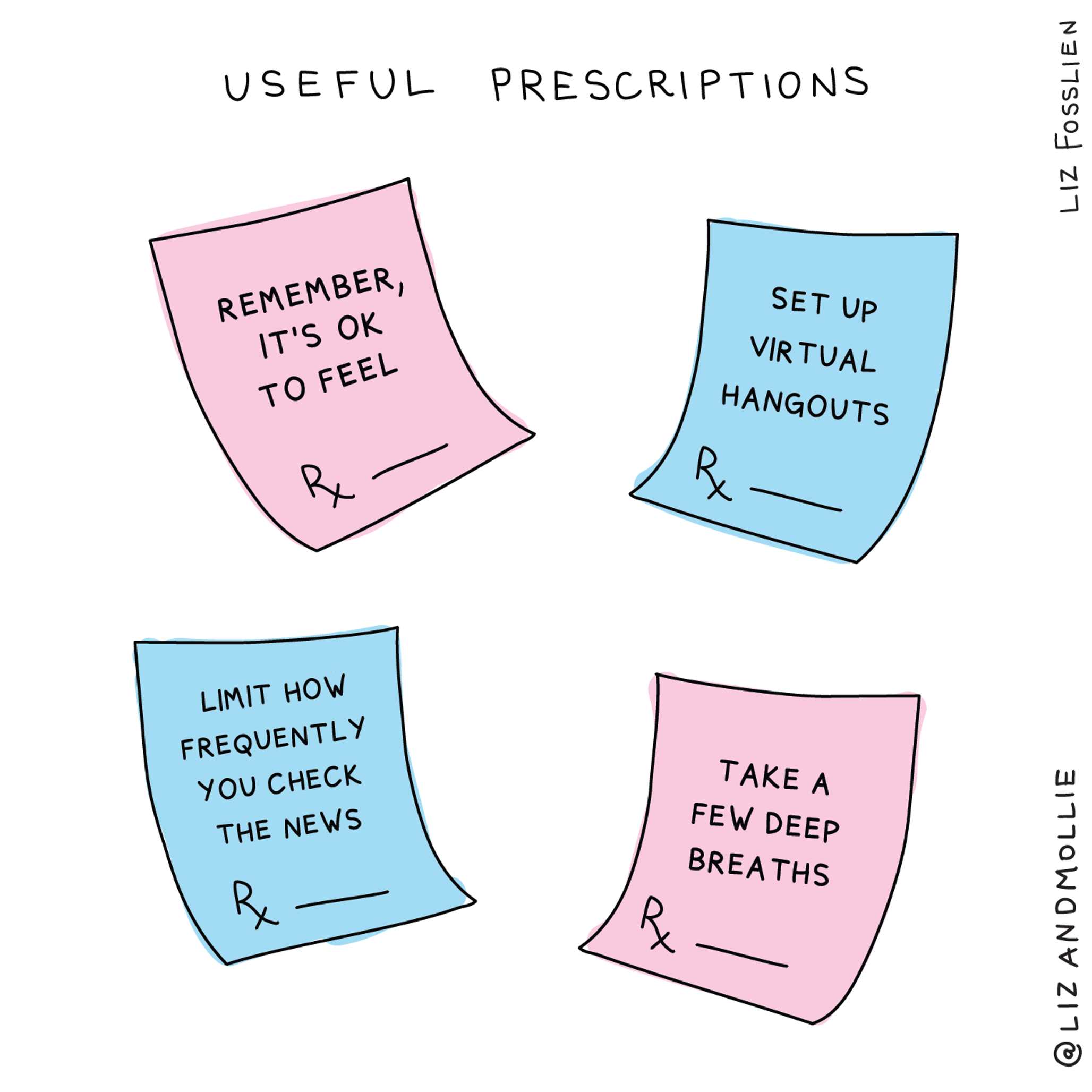
Try to tame the urgency — and don’t layer on judgement.
“Personally, the first few days of staying at home were a blur. My partner and I were trying to convince our parents to stay home and then coordinating getting them enough groceries to last a while. On top of that, I was going to work meetings while adjusting to working from home and trying to figure out how many of my projects needed to shift direction. And now, several weeks in, I’m finding that everything is still heightened. I get more easily irritated by an email. I read into a Slack message in a way that I normally wouldn’t,” says Fosslien.
“If you’re finding that you’re reacting — and perhaps overreacting — in similar ways, take a step back and remind yourself: ‘This might not be about this specific person or work situation. This is happening because I'm anxious and scared about the future.’ Take a beat before you respond. Label the emotion and pinpoint where it’s coming from. Don’t judge what you’re feeling, but don’t let it taint that relationship,” she says.
Try voicing what you’re feeling to diffuse fights before they happen, either with your co-workers, co-founder or your significant other. “I just had a conversation with my partner recently where I said: ‘We’re both in an extremely emotional, heightened state. We're also going to be living together in a confined space. We're each going to be on calls all the time. So, I think it's worth flagging that this is an unusually stressful time, and we need to give each other the benefit of the doubt and approach every conversation with love and intention.”
This might seem like straightforward counsel, but Fosslien finds that it’s worth underlining. “There’s so much urgency in many parts of your life right now. You need to figure out logistics with homeschooling your kids and check in on your loved ones. Maybe your partner was laid off. Even getting food is a stressful experience. It’s easy to bring that same energy to work,” she says. “Your company is probably shifting priorities and perhaps even pivoting. You’re getting messages and notifications in every digital tool you use. But it’s important to remember that while everything seems hectic and urgent, you don’t need to respond to every email immediately. If you feel yourself spiraling or slipping into a heightened state, sleep on things and respond to less important emails in the morning when you're a little more calm. Or take the time to do 10 jumping jacks or walk around the block if you can.”
Don’t let a sense of urgency in one part of your life bleed into every single other area. Not everything is urgent right now. Some emails can wait.
Give yourself space, but don’t throw structure out the window.
Many of us are feeling out of balance and unable to properly focus, which is why most “productivity hacks” are falling flat, Fosslien observes. “I’ve seen this on Twitter a lot: ‘You are not working from home; you are at your home during a crisis, trying to work.’ Inbox zero can seem like a silly goal right now. I find my motivation comes in fits and spurts. There have been some afternoons where I feel like I can’t focus or do anything,” she says. “But then it’s 8 p.m. and I feel ready to tackle that project I’ve been putting off. I’m energized and end up working for hours. Recognize the ebbs and flows and give yourself space to readjust. Drop the idea that you’re going to be — or have to be — productive between the traditional 9 to 5 window at all times.”
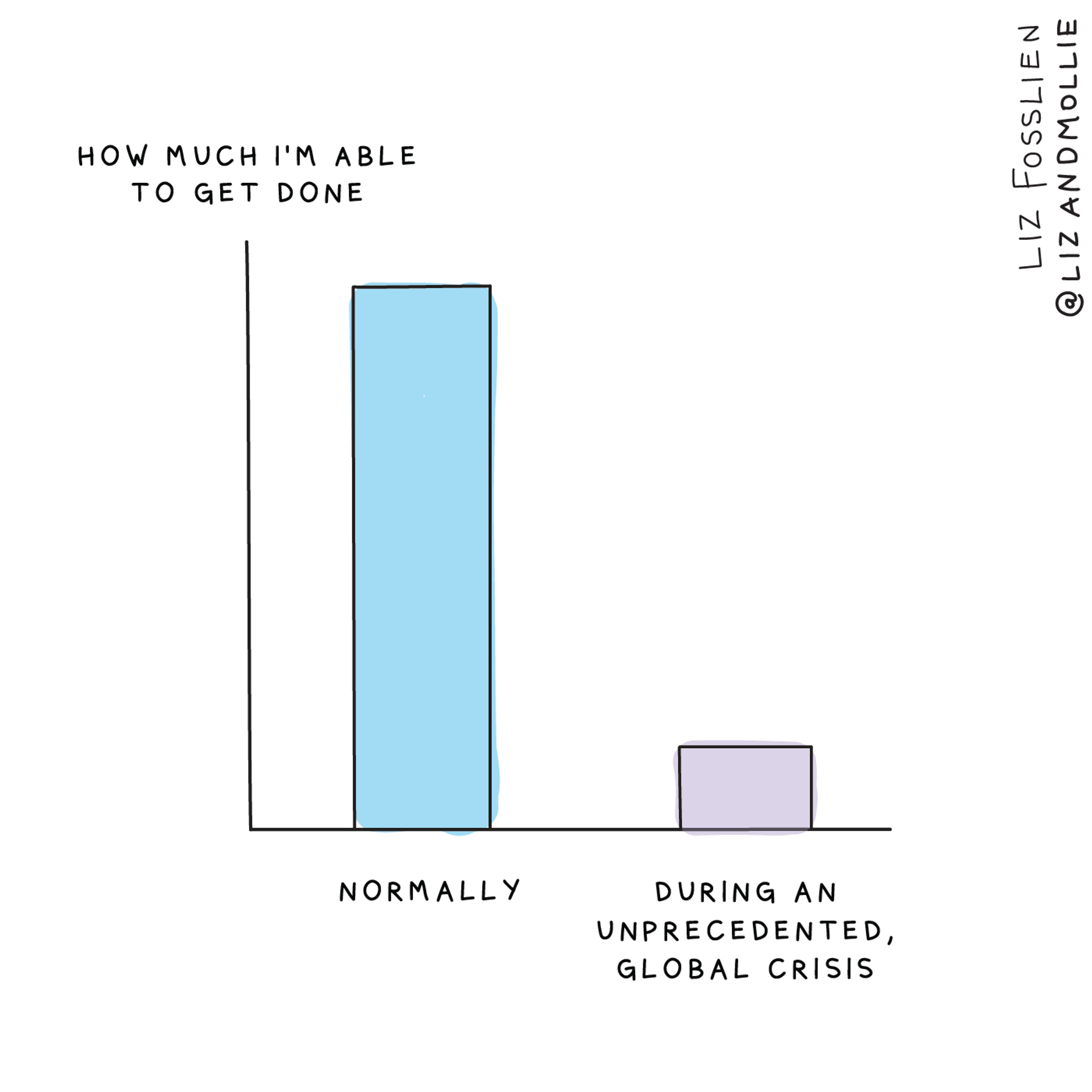
While it’s important to give yourself a wide berth, Fosslien finds it’s helpful to add a dose of structure where you can. “When you relax the boundaries of work and life, routine goes out the window. I often find myself at 3 p.m. in my pajamas, realizing I’m still on my laptop and haven’t eaten yet. That’s not a recipe for getting things done or staying sane. You can’t pour from an empty cup.”
Here are two simple tips for balancing the space you need and the routine you may be craving:
- Write down three things. “We use this routine at Humu and it’s really applicable now. Every morning, write down the top three things you want to accomplish today. If an evening wind-down routine works better for you, ask yourself: what three things do I want to accomplish tomorrow? Those goals can serve as your guidepost,” she says. “I frame it for myself as: If I do take care of these three things today, then I can feel okay about feeling like I’m in a bit of a fog or pausing for a midday break to bake something. I can make room for the space I need, while still feeling like I’ve accomplished something."
- Remind yourself to commit to movement. “I’ve been surprised at how much I’m struggling to just remember to get out of my chair,” Fosslien says. “It’s so easy to forget about exercise or moving your body throughout the day, but it’s so important, not only for your well-being but also for your performance at work. One study found that Danish students who were given a short break before taking a test got significantly higher scores than their peers who didn’t get any time to relax,” she says. Here’s how to fit it in: “My co-author Mollie swears by the Time Out app to schedule her reminders to take periodic breaks to change positions, walk or get some stretching in. Research also shows that if you commit to something, you're more likely to do it. At Humu, one of my co-workers started an exercise commitment thread, where we each reply with an exercise we’re going to do that day and then put time on our calendar to do it."
Combat isolation
If you’re feeling isolated, you’re not alone. “All of us are grieving something right now, even if it’s just the loss of your normal life. It’s common to feel alone during times like this,” she says. “Sharing what you’re experiencing and investing in human connections can help you feel better. Just knowing that other people are having similar emotions can be really comforting.”
But it’s not just about cramming your calendar with calls. “You could host a virtual happy hour right now and everyone might still walk away feeling isolated,” says Fosslien. “It’s important to talk about what you're feeling, ask people what they're feeling and truly check-in on each other — not just in a superficial or perfunctory way.”
It's such an important time to feel like we're here for each other. If we can find creative ways to be supportive — beyond responding to emails or hopping on a video call — we’ll start to cut through this fog of isolation we’re all enveloped in.
To fight feelings of isolation and loneliness, lean on these tips for meaningful check-ins:
- Offer up options. “We’re all hearing the advice that we should ‘check in’ on each other. But what we’re not hearing about as much is that can look really different for different people. I texted one of my friends at the beginning of the day and said, ‘Hey, I would love to check in. Do you want to talk at three and see if we should just text, get on the phone, or do a video chat?’ Picking a platform is a subtle, but important distinction to make,” says Fosslien, “Because sure enough, by the time the afternoon rolled around, I’d been on screen all day and had more virtual chats with friends ahead of me. So we decided to chat on the phone.”
- Keep your normal social routines. “At Humu, we’ve created Lunch Bunch as an opt-in way to keep our regular routine of eating lunch with our teammates. If you put your name in, then you get randomly assigned with three other people at the company for an hour lunch to just catch up and chat,” says Fosslien. “If you used to call your mom on your commute home or go to yoga every Sunday with your friend, try to hold space for those routines on your calendar and do them virtually.”
- Look for other ways to take care of each other. “People are really looking for other ways to show up for each other. Someone at work posted on Slack about not having toilet paper, and several of my coworkers who lived nearby offered to drop some of theirs off on the doorstep,” says Fosslien. “How can you show up for the people in your life? Maybe you could support your favorite local restaurant by ordering takeout. Order a book from your neighborhood bookstore and ship it to a friend. Try introducing some activity, instead of just taking these personal calls from your work setup. Throw on your headphones to take the call outside as you walk around the block. FaceTime each other while you try out the same recipe.”
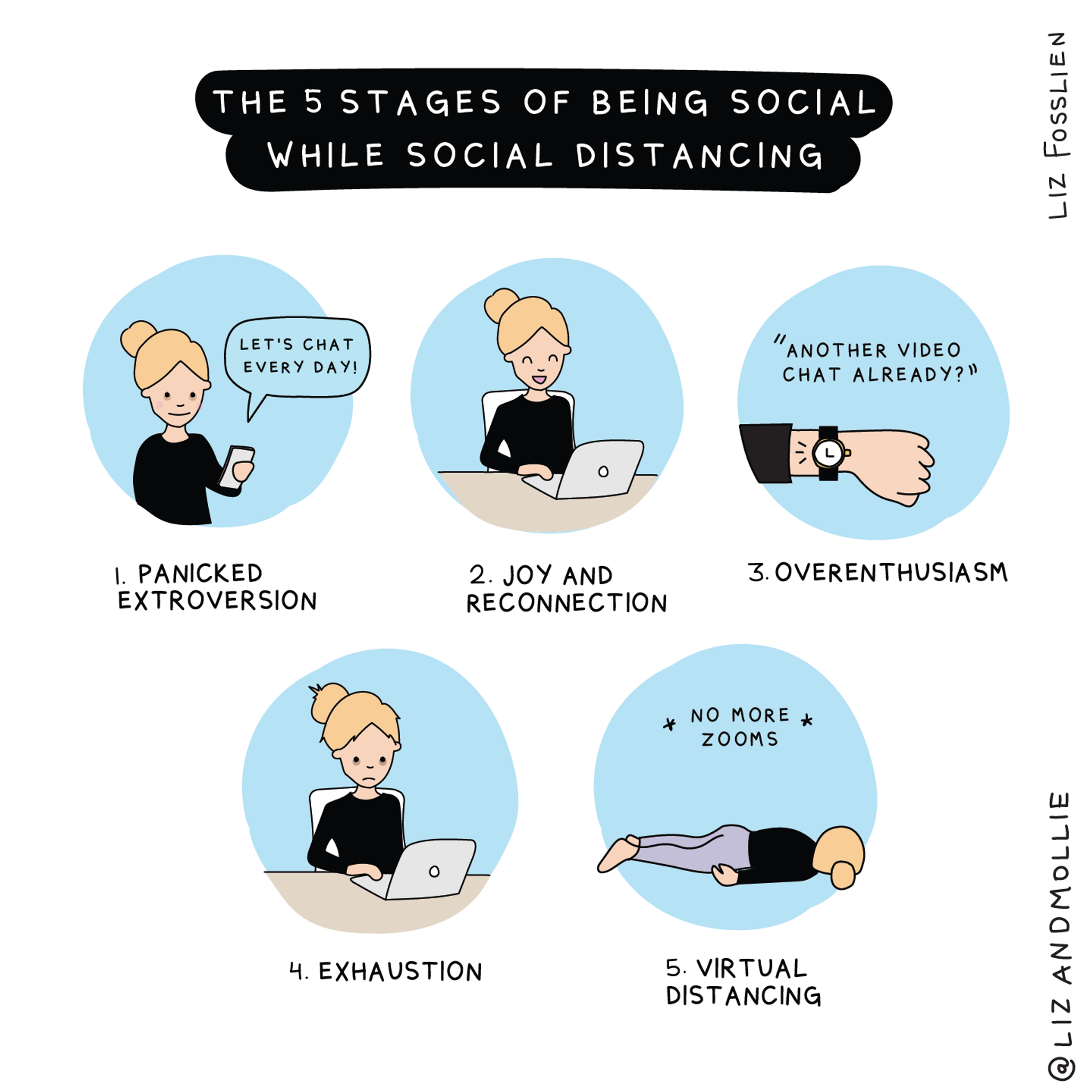
Soothe stress and anxiety with this framework.
These emotions might seem similar and all tangled together, but Fosslien recommends separating them out. “Stress is about the short-term. Will the grocery store have what you need? How can you finish these projects for work today with your kids running around at home? Anxiety is more long-term. It’s worrying about the future, whether you’ll have a job or get sick, for example. Everyone is feeling a lot of both right now,” she says.
“In the book, we suggest using a framework to untangle them. Take 15 minutes to create a list of everything that you’re worried about. Then label each one as a ‘within’ or a ‘beyond’ to see your sources of stress and anxiety laid bare. Beyonds are outside of your control. Withins are issues that you can act on. You can’t control macroeconomic conditions. But you can revisit your budget, make a plan for when you’ll go shopping and what you’ll buy, or learn something new that helps you in your job or job search.”
Separate what you can control from what you can’t. It’s a small way to lift some weight off your shoulders.
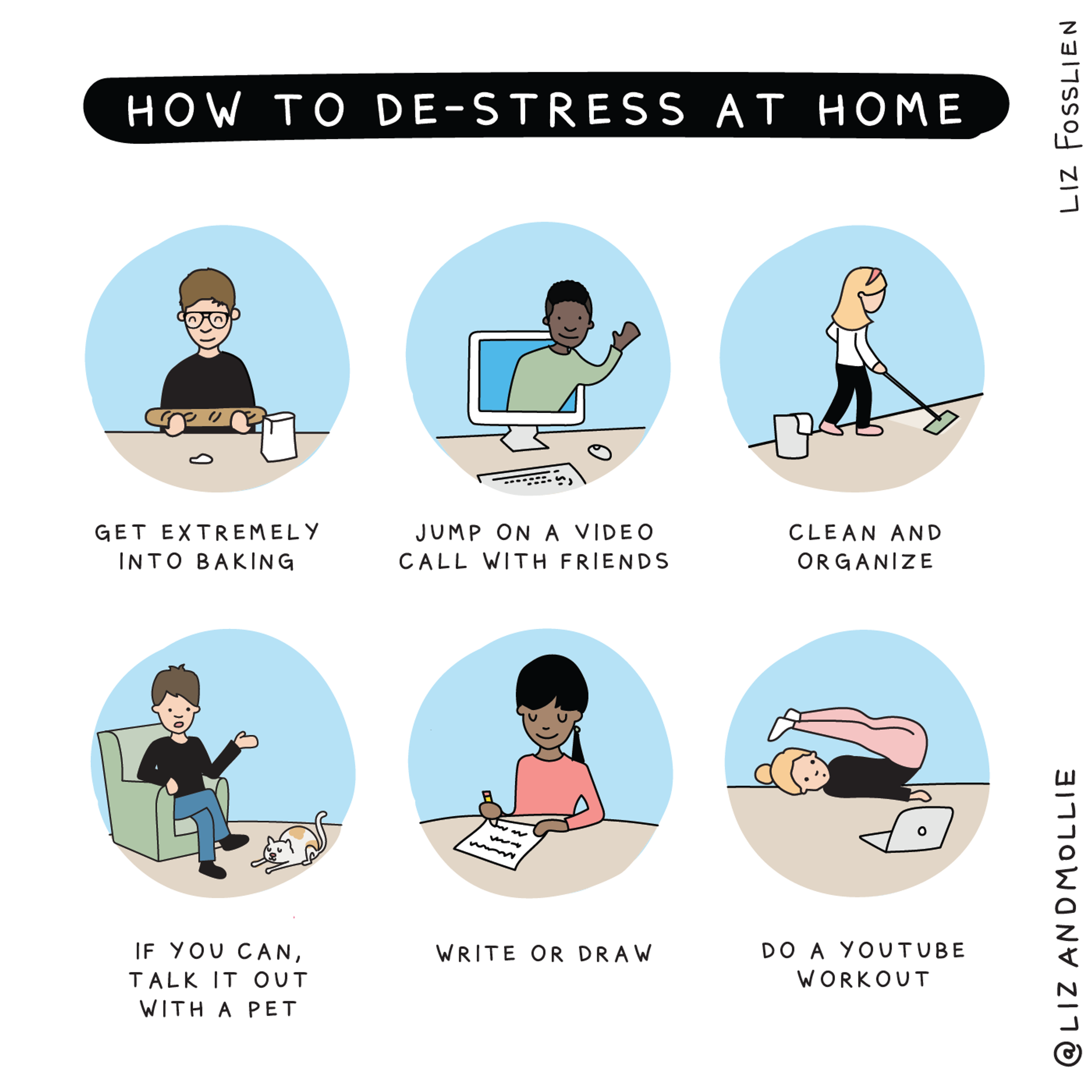
Navigate the emotions that envelope a layoff.
Unfortunately, far too many of us know a friend, family member or co-worker even who have already been affected by layoffs. While there are resources for execs on how to plan for and lead through layoffs, the emotional storms on the other side of the equation are far more devastating. Here's Fosslien's advice for navigating this difficult situation on a human-to-human level:
If your friend loses their job, make sure you avoid jumping into “fix it” mode. “Many people who are not impacted by layoffs end up feeling helpless or even guilty because they’re fortunate to still have jobs,” says Fosslien. “And sometimes they channel or express that in unhelpful ways. I immediately want to help people start thinking of next steps and offer resume help, but it’s too often soon. There’s nothing you can do to make this a positive experience for them. It’s better to listen and let them grieve the loss. Reach out to show you care, but be ready to have them not want to talk to you yet. This is a moment when the most important thing is empathy. Consider sending them an email or a text, with the explicit caveat that they don’t have to respond,” she says.
The same applies to co-workers who have been affected. “Never make it about yourself. Yes, it’s hard to see a friend and colleague get laid off. But they have it much worse. When they’re ready, do what you can to help them land on their feet. Open your network to them, look over resumes, be a support system,” she says. “More tactically, you can also let them know how much you enjoyed working with them and add specific examples. You can’t change what happened, but you can help them remember all the things that make them special, and to feel like they did valuable work. As you keep in touch, avoid ‘could haves’ at all costs. Saying something like ‘This project could have been so amazing if we could have kept you,’ will only make them feel worse.”
Finally, if you’ve personally been impacted by layoffs, Fosslien’s main advice is to give yourself dedicated time to grieve and sit with feelings of sadness. “You need this time to process, or it'll come out in unhealthy ways. Consider setting a ‘cut-off date’ or time when you’ll start mapping out a plan for your next steps. Unfortunately, given the economic environment, you’ll probably need to make your grieving period shorter than normal, but it’s important to not skip over this step if you’re able,” she says.
“Once you’re ready to resurface, don't be afraid to reach out for help or to take people up on their offers to introduce you to others. While shame, fear and pride might threaten to stand in the way, remind yourself there’s nothing to be ashamed of and start putting yourself out there. Use this as a chance to really think through the work you loved — and didn't love — doing as you consider new roles and companies.”
Note from First Round: If you’ve been laid off, check out these resources we've curated here. Several First Round-backed startups are still hiring, and our talent team is ready to help get you in front of them. If you work at a company that’s still actively hiring and would like to get in touch with newly available candidates, we’ve also collected some helpful resources for you here.
LEADING WITH EMPATHY: TACTICAL TIPS FOR MANAGERS
A manager’s job is always challenging, but adding change, uncertainty and physical distance into the mix makes it all the more difficult. “It's a delicate balancing act for leaders right now. You need to be there for all of your employees while still giving them space. You’re worried about maintaining culture and cohesion while still trying to move the ball forward on key projects,” says Fosslien.
“The simple truth is that during a crisis, people are going to care less about work than about their loved ones. As a manager, make sure you’re not adding unnecessary stressors to their plate. And remember that how you lead people through this crisis will have long-lasting effects,” she says. “It’ll determine the level of talent you’re able to attract and retain down the line. In a few years, I expect a lot of candidates will ask during the interview process: ‘How did you or your organizations respond to the COVID crisis?’”
Another challenge is that many managers — especially those without any remote management experience — are quickly realizing how much they relied on the tool of physical proximity. “We have fewer natural opportunities to praise each other, share updates, catch up on our personal lives or quickly discuss problems by jumping into a conference room. Those informal bump-ins are key, and they’re harder to engineer remotely,” she says.
The bottom line? Put way more effort into reaching out, connecting with and caring for your team than you think you need to.
Below, Fosslien shares her advice on four common challenges managers might be facing right now:
1. Balancing bringing the team together while giving everyone space:
“People are in really different places emotionally and in terms of what they have going on at home. Maybe they live alone. Maybe they are supporting a partner who just lost their job. Some have young kids at home that require a lot of attention, while others are helping their kids home from college readjust. There are folks who are taking care of elderly parents, or who can't take care of them because they’re far away and then that's a stressor. And so while virtual happy hours or game nights are an amazing way to stay connected as a team, everything should be opt-in,” says Fosslien.
- Give people an (opt) out. “More than at any other point in time, one size absolutely does not fit all here. Some are craving interaction, others aren’t or aren’t able to fit it into their hectic days. Give people the benefit of the doubt if they’re not showing up — and make sure they know they have it. You don’t want to add social pressure or worries about how they’re being perceived to their list of stressors. Call this out explicitly in your team meetings, letting them know it’s perfectly fine for anyone to opt out and they can always talk to you 1:1 if they’re struggling.”
- Add some official time off. Create even more space for your team by doing everything you can to smooth this switch to remote work. “At Humu, we’ve introduced half-days on Fridays, to give everyone that time to figure out new routines, check in on family or decompress by taking a few hours to do nothing. It’s explicit, no one can schedule meetings during that time,” says Fosslien.
Giving people a day off doesn’t matter in the long run — and it can go so far as we all struggle to find our sea legs.
- Say hi to the pets. As most have acknowledged, these aren’t standard working from home conditions, so most team meetings will have more interruptions than usual. “The leadership team at Humu has made it very clear that we all know there’s a messy amalgamation of work and life going on behind the scenes,” says Fosslien. “If your kid or your pet bursts onto screen, or if there's a commotion behind you, it's fine. Do what you need to do and don’t feel like you have to rush off the call. And you’re not allowed to apologize! We’ll all say hi and then catch you up on what you missed.”
- Spot check for unstructured time. Another tidbit is to check in to make sure your direct reports’ calendars aren’t getting too full. “Non-meeting blocks are essential. We have so many breaks built into our regular workdays, from getting coffee and grabbing lunch to commuting and even just going to the bathroom,” says Fosslien. “Check in during your 1:1 meetings to see how their schedule is shaping up for the week. If their plate seems too full, see what you can move around or cancel to give them some more white space. Model good behavior by proactively putting chunks of time on your own calendar and encourage your direct reports to do the same.” Or consider scheduling 25- or 50-minute meetings rather than the typical 30 minutes or one hour to make sure everyone (including you) has time between virtual calls to take a quick break.
2. Communicating with your team:
“On the one hand, it feels tone-deaf to just move forward business-as-usual. But then on the other hand, it’s still true that your job as a leader is to provide stability by planning out and communicating a path forward. In everything you do, you want to make sure you’re reducing anxiety, not contributing to it. That takes a lot of emotional work,” says Fosslien.
Here are some more tactical tips for striking the right tone with your team in your meetings and internal communications:
Use your EQ to quickly check in.
Spend the first five minutes of a meeting just asking people how they are doing. “Feel it out. Either they want to talk or they don’t, which is fine too, but don’t get straight to business in a way that stifles those conversations,” says Fosslien. “The research shows that someone who is scared or intensely anxious is not going to be productive. Taking the time to address their concerns, even if you don’t have all the answers, can go a long way toward helping them feel better — and be able to focus.”
Lay your cards on the table.
Being as open as you can about your financial state and strategic direction is important, especially if you’re at a startup where there was probably already lots of change and uncertainty. Fosslien points to Humu CEO (and former Google Senior Vice President of People Operations) Laszlo Bock as an example: “He recently told our team — and I’m loosely paraphrasing here — ‘We know this is a challenging time. For the next year or two, the economy is going to be very different than we thought it would be a few months ago. Needless to say this is going to be a very different year than we’d originally planned. Here's how we're responding to the market and planning to move forward. If you have any questions, I’m here to talk,’” she says.
“There were two things about this response that stood out to me: He acknowledged emotion, and didn’t mince words about it. But then he laid out a map of what the next months might look like. Obviously this could change, but sharing what you know and your current path forward provides stability for people and soothing their anxieties,” she says. There’s another important benefit here as well. “Your people can't help you get there unless they know where you're going. This is especially helpful for managers, who can use transparent direction to help their team get clear on priorities.”
This is a time when you don't need to have all the answers. But as a leader, you can’t clam up either. Stay thoughtful and share as much as you can — but don’t sugarcoat it.
Over-communicate.
“You need to significantly increase the frequency and change the formats of how you communicate with your immediate team, or the whole company if you’re a founder. Start by erring on the side of over-communication, and then after a couple of weeks you can figure out what communication tools you actually need and what feels right. It’s going to feel weird and repetitive at times. But that's just part of it. It's better to over-communicate than not to,” says Fosslien.
Put more (quick) team meetings on the calendar than you’re comfortable with. Send too many update emails. You can always back off later as you make your way to a new normal, but times of crisis call for overcommunication.
“At Humu, we now have a 15-minute daily standup that the entire company joins. Our leadership team has also been giving regular updates where they broadly share meeting outcomes. Things like, ‘Today we met with the sales team, here's what came out of that meeting,’” she says.
“We’ve also spun up several new Slack channels. There’s one with work from home tips that people are sharing. We have a COVID channel for sharing news and resources, which I honestly don’t look at very much because my Twitter feed feels overwhelming enough. And we also have a #Unfun channel, which is where people can publicly share what's going on with their families and what they’re going through emotionally if they want to, so we can all know what’s going on and try to help.”
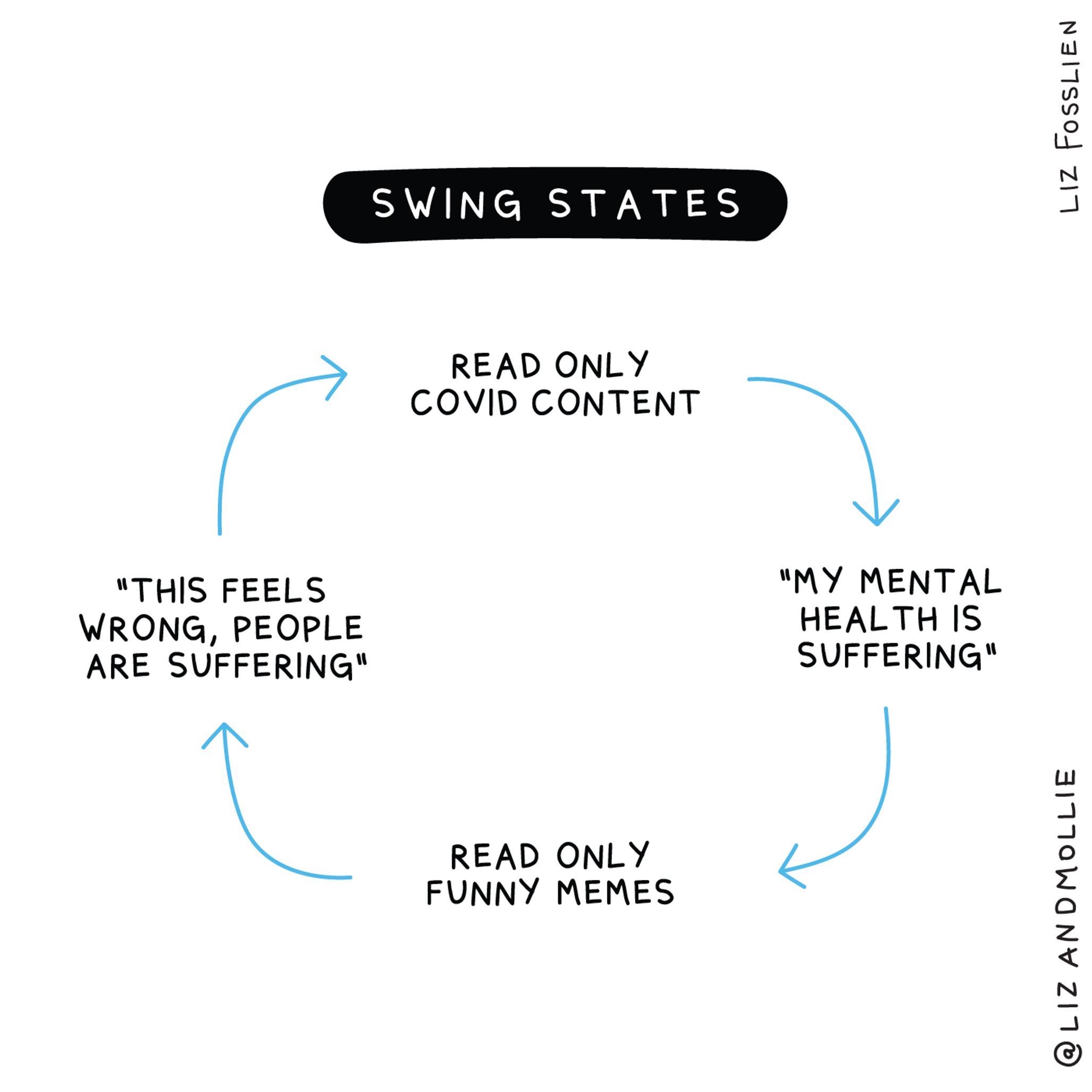
3. Reorienting your team’s work:
Many startups are scrambling to adjust their strategy, support their customers or outright pivot in order to respond to opportunities — or crushing challenges — in their respective markets. And managers are on the frontlines of turning these ships.
Humu is in the same boat, says Fosslien. “We’re trying to be as responsive as possible. It's a completely unprecedented time for our customers. We work with some partners in industries that have been severely impacted by the crisis. Our people scientists have put together many guides on navigating uncertainty and how to lead through a crisis. We're also offering a new solution that nudges people towards the habits that make them better able to work from home, stay connected to their teams, and invest in their own resilience,” she says.
There’s also been a tremendous outpouring of “helpers” in this crisis. Many startups are eyeing what they can contribute, both to their communities and to their customers. “Our mission at Humu is to make work better for everyone, everywhere — and so many are struggling with anxiety and the shift to remote work right now. Our team decided that if we can help anyone, we should do it. So that’s led us to offer a modified version of our nudges — short, scientifically-backed coaching moments — to anyone who wants them,” says Fosslien.
“Normally, we take in a range of data to offer tailored and customized nudges for every person within a company. But to move as quickly as possible to help, we created more generally useful email nudges. All we ask is for your name and work email, and then a couple times of week you’ll get scientifically-backed suggestions about how to navigate uncertainty and work better remotely sent to your inbox. As an example, the first one we send out encourages people to create a virtual water cooler. At Humu we have a Google Hangout where anyone can pop in at any time to chat or just keep the camera on and have some ambient co-workers in the background.”
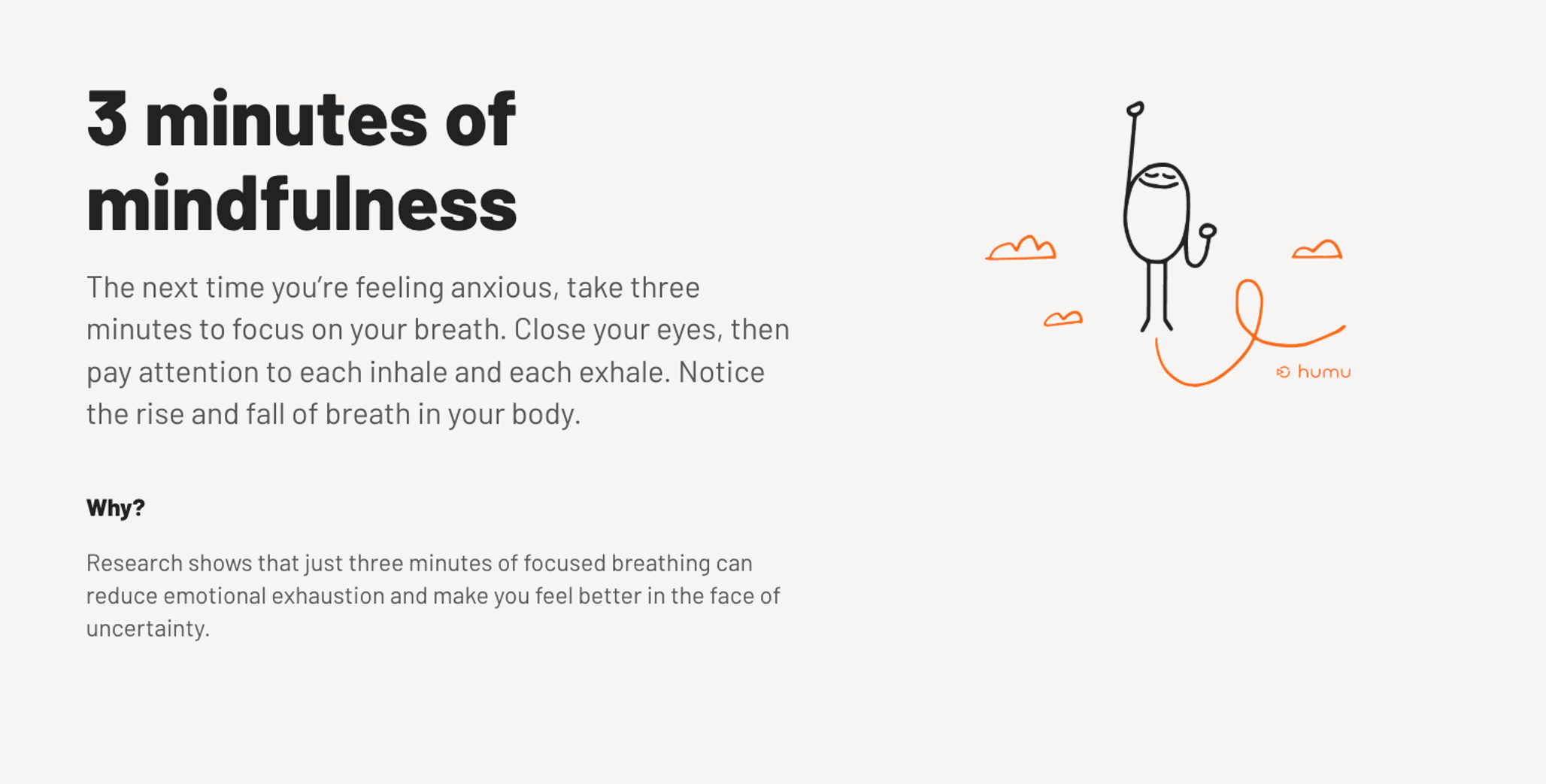
This work to roll out new initiatives and continue building the plane while flying in stormy weather can bring on a slew of emotions. “Offering something different takes work. Humu has always been an enterprise product, so we had to quickly figure out how to provide people with something useful, without relying on the level of information or onboarding options we usually have. But the response has been amazing, and it feels important to do something in a way that rings true to our mission,” says Fosslien.
As a manager, it’s important to flag the feelings your team might be experiencing through these twists and turns. “Level set expectations. Explicitly say, ‘Hey, we're trying something new. We might hit barriers, or experience stressful moments along the way. That’s okay. Let’s give each other the benefit of the doubt, over-communicate, and come together to build what is most valuable for others now,’” she says.
Experimentation internally has been key to cutting through this stress. “Remove roadblocks together. If there's something specific about your work that's stressful, or a new challenge you’re wrestling with, schedule time with a few colleagues to figure it out,” says Fosslien. “At Humu, my colleague Robbie suggested a ‘ThinkGroup,’ which he learned while working as part of the UK's Behavioural Insights Team, an organization that uses behavioral science to improve public policies.”
Here's how it works: “It’s a brainstorm exercise where the facilitator poses a problem in a spreadsheet, and then everyone on the call takes 10 minutes to silently and anonymously add possible solutions to the problem. Afterwards, each participant goes in and votes for the top 10. After the meeting, a few team members look through the top picks, prioritize a couple of directions, and then make a plan to move forward.”
4. Taking time for your own self-care:
Finally, managers need to turn their attention inward. “There’s a lot of pressure on your shoulders right now. You may be feeling a need to be stoic for your team, like you have to button up and repress a lot of what you’re feeling,” says Fosslien. “You want to be there for everyone, and often that means that you overlook yourself.” One tactic that’s been helpful has been chatting with friends in similar positions. “We had a half hour sync just to talk about how to work through shared challenges, and that felt really cathartic.”
Protecting yourself emotionally is the best thing you can do to protect your reports emotionally. Think about how your actions are going to affect someone else's day.
“Here’s what I mean by protecting your own emotions as a manager: If you get overly anxious, you're going to start furiously sending emails at night, frantically trying to catch up or make progress on something that suddenly seems so important. That's when you really stress out your reports, because then they're going to feel obligated to respond right away, and then their stress ripples through the company,” says Fosslien. “So managing your own anxiety and emotions is critical to leading your team through these times.”
As a gut check to make sure you’re doing that work and sending the right signals, she recommends emotionally proofreading your messages before you hit send. “Everyone’s in a heightened state, where errant punctuation, typos and emoji choices can be overanalyzed and misconstrued, causing it to spiral much more than usual,” she says.
Zooming out of the nitty-gritty tactics, Fosslien closes with a helpful reminder. “This crisis has crystallized what's really important for me, which is health and safety, and the need to support others as best I can. My internal mantra has become, ‘I’m going to try my best at work, but it’s also okay if I’m not at 100% in every moment. I trust in my team, and I’m investing in my own resilience. We’ll get through it, together,’” she says.
“I always return to gratitude as well. So many families are struggling. Not everyone can work from home. Not everyone still has work. Essential workers are forced to go out into the world every day, putting themselves at risk. Thank them, practice social distancing, donate if you’re able — taking care of each other is a prescription for lifting our spirits.”
